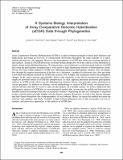| dc.contributor.author | Abunimer, Ayman N. | |
| dc.contributor.author | Noursi, David P. | |
| dc.contributor.author | Abu-Asab, Mones S. | |
| dc.contributor.author | Salazar, Jose A. | |
| dc.date.accessioned | 2017-05-01T15:47:54Z | |
| dc.date.available | 2017-05-01T15:47:54Z | |
| dc.date.issued | 2016-03 | |
| dc.identifier.issn | 1536-2310 | |
| dc.identifier.issn | 1557-8100 | |
| dc.identifier.uri | http://hdl.handle.net/1721.1/108530 | |
| dc.description.abstract | Array Comparative Genomic Hybridization (aCGH) is a rapid screening technique to detect gene deletions and duplications, providing an overview of chromosomal aberrations throughout the entire genome of a tumor, without the need for cell culturing. However, the heterogeneity of aCGH data obfuscates existing methods of data analysis. Analysis of aCGH data from a systems biology perspective or in the context of total aberrations is largely absent in the published literature. We present here a novel alternative to the functional analysis of aCGH data using the phylogenetic paradigm that is well-suited to high dimensional datasets of heterogeneous nature, but has not been widely adapted to aCGH data. Maximum parsimony phylogenetic analysis sorts out genetic data through the simplest presentation of the data on a cladogram, a graphical evolutionary tree, thus providing a powerful and efficient method for aCGH data analysis. For example, the cladogram models the multiphasic changes in the cancer genome and identifies shared early mutations in the disease progression, providing a simple yet powerful means of aCGH data interpretation. As such, applying maximum parsimony phylogenetic analysis to aCGH results allows for the differentiation between drivers and passenger genes aberrations in cancer specimens. In addition to offering a novel methodology to analyze aCGH results, we present here a crucial software suite that we wrote to carry out the analysis. In a broader context, we wish to underscore that phylogenetic analysis of aCGH data is a non-parametric method that circumvents the pitfalls and frustrations of standard analytical techniques that rely on parametric statistics. Organizing the data in a cladogram as explained in this research article provides insights into the disease common aberrations, as well as the disease subtypes and their shared aberrations (the synapomorphies) of each subtype. Hence, we report the method and make the software suite publicly and freely available at http://software.phylomcs.com so that researchers can test alternative and innovative approaches to the analysis of aCGH data. | en_US |
| dc.language.iso | en_US | |
| dc.publisher | Mary Ann Liebert | en_US |
| dc.relation.isversionof | http://dx.doi.org/10.1089/omi.2015.0184 | en_US |
| dc.rights | Article is made available in accordance with the publisher's policy and may be subject to US copyright law. Please refer to the publisher's site for terms of use. | en_US |
| dc.source | Mary Ann Liebert | en_US |
| dc.title | A Systems Biology Interpretation of Array Comparative Genomic Hybridization (aCGH) Data through Phylogenetics | en_US |
| dc.type | Article | en_US |
| dc.identifier.citation | Abunimer, Ayman N., Jose Salazar, David P. Noursi, and Mones S. Abu-Asab. “A Systems Biology Interpretation of Array Comparative Genomic Hybridization (aCGH) Data through Phylogenetics.” OMICS: A Journal of Integrative Biology 20, no. 3 (March 2016): 169–179. © 2016 Mary Ann Liebert, Inc | en_US |
| dc.contributor.department | Massachusetts Institute of Technology. Department of Electrical Engineering and Computer Science | en_US |
| dc.contributor.mitauthor | Salazar, Jose A. | |
| dc.relation.journal | OMICS A Journal of Integrative Biology | en_US |
| dc.eprint.version | Author's final manuscript | en_US |
| dc.type.uri | http://purl.org/eprint/type/JournalArticle | en_US |
| eprint.status | http://purl.org/eprint/status/PeerReviewed | en_US |
| dspace.orderedauthors | Abunimer, Ayman N.; Salazar, Jose; Noursi, David P.; Abu-Asab, Mones S. | en_US |
| dspace.embargo.terms | N | en_US |
| mit.license | PUBLISHER_POLICY | en_US |
| mit.metadata.status | Complete | |
